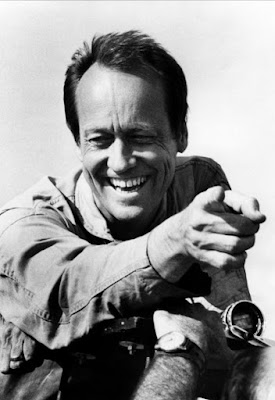Back in the 60s and 70s, when TrustMovies endured his late-coming-of-age period, Kurt Vonnegut was one -- maybe the --most favored novelist of those of us in or near the boomer generation. I think his work holds up pretty well, and so does the movie version of one of his most popular and enduring novels, SLAUGHTERHOUSE-FIVE, directed by George Roy Hill (shown below, an Oscar-winner for The Sting and a nominee for Butch Cassidy and the Sundance Kid), with a good screenplay that follows the book well yet not too slavishly from Stephen Geller.
What might seem missing from the movie -- this being but an adaptation rather than the original -- is the peculiar, particular Vonnegut tone. For instance, the refrain that echos through the novel, So it goes, is nowhere to be found in the film. Not literally, and yet Hill and Geller find their own right tone that carries through their movie so that So it goes -- which you can interpret as icy irony, a kind of capitulation, or perhaps an acceptance of things as they are rather than how you might like them to be -- is there in the film without ever having to be spoken aloud. Via the manner in which this movie builds and coalesces, this now famous phrase seems absolutely part and parcel.
Slaughterhouse-Five is a combination time-travel sci-fi/philosophical treatise novel, and it works equally well as both. One of the things that Hill and Geller get right and handle extremely well is the constant zipping back and forth from past to present. This is so quietly and subtly managed that audiences back in 1969 may have been unprepared for something this skillful. Even today, some 47 years later, it seems fresh.
The movie also brought to filmgoers' attention a new actor named Michael Sacks (above), who then and now seems a perfect fit for Vonnegut's based-upon-himself-as-a-young-man hero. Sacks never had a long nor hugely memorable career in films but his performance here in the role of Billy Pilgrim was about as good as could be.
Although I saw the film when it first came out, watching it again became a new experience. Yet as much as I was enjoying it, Slaughterhouse-Five seemed as though it lacked a certain depth and raison d'être as it moved along. Then, around three-quarters of the way through -- the point at which Billy's explanation of the philosophy of the time tripping Trafalmador coincides with the burning of the corpses found after the WWII fire-bombing of Dresden, for this viewer at least, the movie took on the profundity that the novel sometimes reached.
From Arrow Video (distributed here in the USA via MVD Visual/MVD Entertainment Group) and running a mere 104 minutes, the movie hit the street last week in a pretty good Blu-ray transfer -- for purchase (and, I hope, rental).









No comments:
Post a Comment